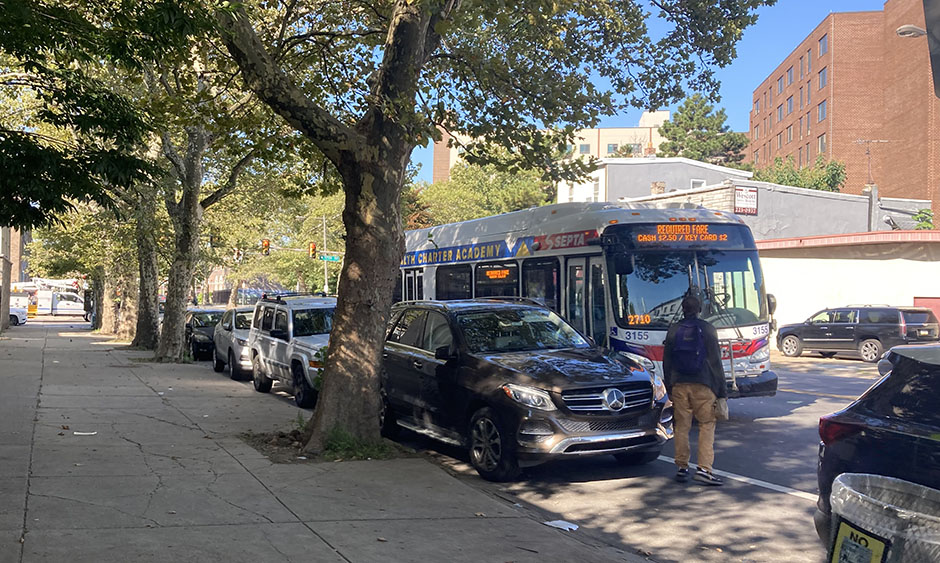
August 8, 2025
Taking transit provides significant air quality benefits. DVRPC modeled how SEPTA's proposed service cuts and fare increases might impact air quality throughout the region.
The Greater Philadelphia region has recently experienced a number of poor air quality days due to ground-level ozone pollution. Long days of bright sun and higher temperatures help bake pollutants from our cars, trucks, and even gas-powered lawn mowers into this harmful pollutant. Unlike the ozone layer in the atmosphere, ground-level ozone is bad for our lungs when inhaled, and especially harmful to older adults with reduced lung capacity and children, whose lungs are still developing. Those who already have respiratory conditions like asthma are also more susceptible to lung damage from summer air pollution.
The good news is that there are steps we can take to improve the air quality. Taking transit provides significant air quality benefits. If you live near a bus route, trolley, subway, or regional rail line, ride transit. This is especially important on poor air quality days–getting out of individual cars and onto public transit can reduce ground-level ozone, making the air safer for everyone. Find other tips for improving air quality on the Air Quality Partnership website.
How Will Potential SEPTA Cuts Impact Air Quality?
Without a permanent funding solution, SEPTA will have to raise fares by more than 20% and be forced to take drastic steps to irreversibly shrink the system, including eliminating 50 bus routes and five regional rail lines, reducing service by 20% on all remaining routes, creating a 9:00 p.m. curfew on Metro and Regional Rail routes, and eliminating all special services, such as sports express service to and from the stadiums.
DVRPC modeled how these proposed service cuts and fare increases might impact air quality throughout the region. The model looked at fine particulate matter (PM 2.5) and the pollutants that make up ozone pollution: nitrogen oxide (NOx), and volatile organic compounds (VOCs). The analysis found an increase in all pollutants. Compared to today, there would be a 3.6% increase of PM 2.5, 3.1% increase of NOx, and a 1.1% increase of VOCs due to the anticipated service cuts and fare increases for 2025. The increase in air pollution would especially be felt in Philadelphia, which would see an increase of 7.9% in PM 2.5, 6.9% in NOx, and 2.3% in VOCs.
Table: Additional Emissions Resulting from Proposed SEPTA Service Reductions
| County | Direct PM 2.5 (tons/year) | NOx (tons/year) | VOC (tons/year) |
| Bucks | 0.46 | 8.02 | 3.36 |
| Chester | 0.75 | 12.74 | 5.32 |
| Delaware | 1.00 | 15.00 | 6.63 |
| Montgomery | 1.99 | 30.99 | 14.32 |
| Philadelphia | 4.95 | 71.55 | 33.39 |
| Total | 9.14 | 138.30 | 63.02 |
These numbers show a similar increase to the expected increase in vehicle miles traveled (VMT) throughout the region as previously modeled by DVRPC. Fewer transit options means more cars on the road, longer commutes, and more congestion. Fifty-five percent of the increase in travel due to the SEPTA cuts will take place off the major highways and on arterials, collectors, and local roadways, which will have quality-of-life, safety, and air quality impacts in neighborhoods across the region. Additionally, on poor air quality days, transit will no longer be an option for many people in the region.
“With the proposed service cuts to SEPTA, traffic impacts will be felt across the region and in every community,” said DVRPC Executive Director Ariella Maron. “Congested roads contribute to poor air quality, which in turn contributes to negative health impacts for people along these congested corridors.”
An increase in pollutants will also challenge the region’s ability to meet air quality standards and requirements. Reduced transit service may impact the region’s ability to pass Transportation Conformity in the future due to both increased air pollution and the inability of people to use less polluting options. Conformity is a federal requirement to demonstrate that the projects in the region’s Transportation Improvement Program (TIP) and Long-Range Plan do not impede the states’ ability to attain air quality standards. If the region is not able to demonstrate conformity, there will be a freeze in federal transportation funding.
To learn more about the service cuts, visit the SEPTA Funding Crisis webpage. If you work for a media outlet and would like to know more about DVRPC’s modeling work, contact Elise Turner at eturner@dvrpc.org.